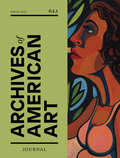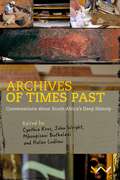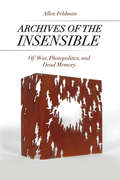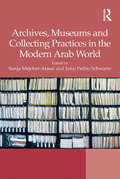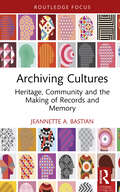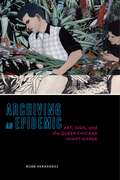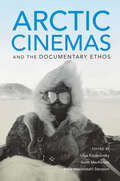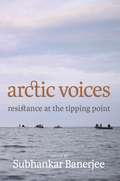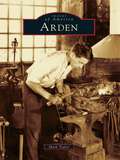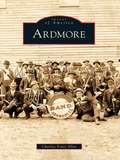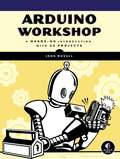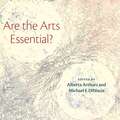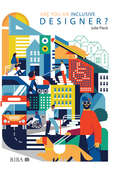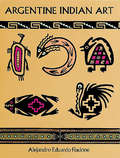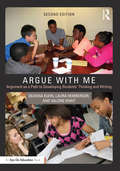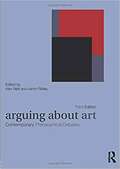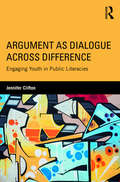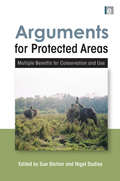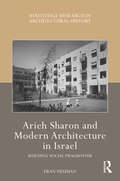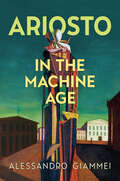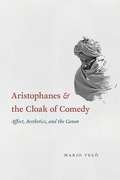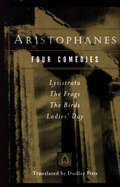- Table View
- List View
Archives of American Art Journal, volume 64 number 1 (Spring 2025)
by Archives of American Art JournalThis is volume 64 issue 1 of Archives of American Art Journal. First published in 1960 as the Archives of American Art Bulletin, the Archives of American Art Journal is the longest-running scholarly periodical devoted to the history of art in the United States. This peer-reviewed publication showcases new approaches to and out-of-the-box thinking about primary sources. All contributions must be appropriate for the journal's broad audience and engage in a substantial, meaningful way with the holdings of the Archives of American Art.
Archives of Times Past: Conversations about South Africa’s Deep History
by Rachel King Amanda Esterhuysen Hlonipha Mokoena Mbongiseni Buthelezi Sifiso Mxolisi Ndlovu Cynthia Kros John Wright Helen Ludlow Geoffrey Blundell Jan Boeyens Lize Kriel Sekibakiba Peter Lekgoathi Grant McNulty Fred Morton Muchaparara Musemwa Ndukuyakhe Ndlovu Himal Ramji Justine WintjesThis volume critically examines sources of evidence and material from the archive that historically have been used to tell southern Africa’s pre-colonial story.
Archives of the Insensible
by Allen FeldmanIn this jarring look at contemporary warfare and political visuality, renowned anthropologist of violence Allen Feldman provocatively argues that contemporary sovereign power mobilizes asymmetric, clandestine, and ultimately unending war as a will to truth. Whether responding to the fantasy of weapons of mass destruction or an existential threat to civilization, Western political sovereignty seeks to align justice, humanitarian right, and democracy with technocratic violence and visual dominance. Connecting Guantánamo tribunals to the South African Truth and Reconciliation Commission, American counterfeit killings in Afghanistan to the Baader-Meinhof paintings of Gerhard Richter, and the video erasure of Rodney King to lynching photography and political animality, among other scenes of terror, Feldman contests sovereignty's claims to transcendental right --whether humanitarian, neoliberal, or democratic--by showing how dogmatic truth is crafted and terror indemnified by the prosecutorial media and materiality of war. Excavating a scenography of trials--formal or covert, orchestrated or improvised, criminalizing or criminal--Feldman shows how the will to truth disappears into the very violence it interrogates. He maps the sensory inscriptions and erasures of war, highlighting war as a media that severs factuality from actuality to render violence just. He proposes that war promotes an anesthesiology that interdicts the witness of a sensory and affective commons that has the capacity to speak truth to war. Feldman uses layered deconstructive description to decelerate the ballistical tempo of war to salvage the embodied actualities and material histories that war reduces to the ashes of collateral damage, the automatism of drones, and the opacities of black sites. The result is a penetrating work that marries critical visual theory, political philosophy, anthropology, and media archeology into a trenchant dissection of emerging forms of sovereignty and state power that war now makes possible.
Archives, Museums and Collecting Practices in the Modern Arab World
by John Pedro Schwartz Sonja Mejcher-AtassiCollecting has a long tradition in the Middle East but the museum as a public institution is relatively new. Today there are national museums for antiquities in most Arab countries. While in some cases the political and social climate has hindered the foundation of museums, with existing collections even destroyed at times, the recent museum boom in the Gulf States is again changing the outlook. This unique book is the first to explore collecting practices in archives and museums in the modern Arab world, featuring case studies of collecting practices in countries ranging from Egypt and Lebanon to Palestine, Jordan, Iraq and the Gulf, and providing a theoretical and methodological basis for future research. The authors are also concerned with investigating the relationship between past and present, since collecting practices tell us a great deal not only about the past but also about the ways we approach the past and present conceptions of our identities. Collections can be textual as well, as in the stories, memories or events selected, recalled, and retold in the pages of a text. As interest in memory studies as well as popular and visual culture grows in the Arab World, so collecting practices are at the heart of any critical approach to the past and the present in that region. The book will be of great interest not only to scholars and students of the modern Arab world but also to professionals in museums and collections in the region, as well as around the world.
Archiving Cultures: Heritage, community and the making of records and memory (Routledge Studies in Archives)
by Jeannette A. BastianArchiving Cultures defines and models the concept of cultural archives, focusing on how diverse communities express and record their heritage and collective memory and why and how these often-intangible expressions are archival records. Analysis of oral traditions, memory texts and performance arts demonstrate their relevance as records of their communities. Key features of this book include definitions of cultural heritage and archival heritage with an emphasis on intangible cultural heritage. Aspects of cultural heritage such as oral traditions, performance arts, memory texts and collective memory are placed within the context of records and archives. It presents strategies for reconciling intangible and tangible cultural expressions with traditional archival theory and practice and offers both analog and digital models for constructing cultural archives through examples and vignettes. The audience includes archivists and other information workers who challenge Western archival theory and scholars concerned with interdisciplinary perspectives on tangible and intangible cultural heritage. This book is relevant to scholars involved with non-textual materials and will appeal to a range of academic disciplines engaging with "the archive".
Archiving an Epidemic: Art, AIDS, and the Queer Chicanx Avant-Garde (Sexual Cultures #36)
by Robb HernándezHonorable Mention, 2021 Latinx Studies Section Outstanding Book Award, given by the Latin American Studies AssociationWinner, 2020 Latino Book Awards in the LGBTQ+ Themed SectionFinalist, 2019 Lambda Literary Award in LGBTQ StudiesCritically reimagines Chicanx art, unmasking its queer afterlife Emboldened by the boom in art, fashion, music, and retail culture in 1980s Los Angeles, the iconoclasts of queer Aztlán—as Robb Hernández terms the group of artists who emerged from East LA, Orange County, and other parts of Southern California during this period—developed a new vernacular with which to read the city in bloom. Tracing this important but understudied body of work, Archiving an Epidemic catalogs a queer retelling of the Chicana and Chicano art movement, from its origins in the 1960s, to the AIDS crisis and the destruction it wrought in the 1980s, and onto the remnants and legacies of these artists in the current moment. Hernández offers a vocabulary for this multi-modal avant-garde—one that contests the heteromasculinity and ocular surveillance visited upon it by the larger Chicanx community, as well as the formally straight conditions of traditional archive-building, museum institutions, and the art world writ large. With a focus on works by Mundo Meza (1955–85), Teddy Sandoval (1949–1995), and Joey Terrill (1955– ), and with appearances by Laura Aguilar, David Hockney, Robert Mapplethorpe, and even Eddie Murphy, Archiving an Epidemic composes a complex picture of queer Chicanx avant-gardisms. With over sixty images—many of which are published here for the first time—Hernández’s work excavates this archive to question not what Chicanx art is, but what it could have been.
Arctic Cinemas and the Documentary Ethos
by Anna Westerstahl StenportA collection of essays analyzing the representation of the Arctic region in documentary films.Beginning with Robert Flaherty’s Nanook of the North (1922), the majority of films that have been made in, about, and by filmmakers from the Arctic region have been documentary cinema. Focused on a hostile environment that few people visit, these documentaries have heavily shaped ideas about the contemporary global Far North. In Arctic Cinemas and the Documentary Ethos, contributors from a variety of scholarly and artistic backgrounds come together to provide a comprehensive study of Arctic documentary cinemas from a transnational perspective. This book offers a thorough analysis of the concept of the Arctic as it is represented in documentary filmmaking, while challenging the notion of “The Arctic” as a homogenous entity that obscures the environmental, historical, geographic, political, and cultural differences that characterize the region. By examining how the Arctic is imagined, understood, and appropriated in documentary work, the contributors argue that such films are key in contextualizing environmental, indigenous, political, cultural, sociological, and ethnographic understandings of the Arctic, from early cinema to the present. Understanding the role of these films becomes all the more urgent in the present day, as conversations around resource extraction, climate change, and sovereignty take center stage in the Arctic’s representation.“Highly recommended.” —Choice“A thorough exploration of the inexorable links between the circumpolar regions and historic and contemporary documentary filmmaking. It will b valuable to Arctic humanities specialists, particularly as a welcome addition to scholarship on visual depictions of the Arctic by authors such as Ann Fienup-Riordan, Richard Condon, Russell Potter, and Peter Geller, as well as Mackenzie and Westerstahl Steport’s earlier co-edited volume, Films on Ice. It will also be of use to anyone interested in ways of studying linkages between filmmaking, environments, and local and outsider communities.” —Sarah Pickman, Yale University, H-Environment, January 2020
Arctic Voices: Resistance at the Tipping Point
by Subhankar BanerjeeA pristine environment of ecological richness and biodiversity. Home to generations of indigenous people for thousands of years. The location of vast quantities of oil, natural gas and coal. Largely uninhabited and long at the margins of global affairs, in the last decade Arctic Alaska has quickly become the most contested land in recent US history. World-renowned photographer, writer, and activist Subhankar Banerjee brings together first-person narratives from more than thirty prominent activists, writers, and researchers who address issues of climate change, resource war, and human rights with stunning urgency and groundbreaking research. From Gwich'in activist Sarah James's impassioned appeal, "We Are the Ones Who Have Everything to Lose," during the UN Climate Conference in Copenhagen in 2009 to an original piece by acclaimed historian Dan O'Neill about his recent trips to the Yukon Flats fish camps, Arctic Voices is a window into a remarkable region.Other contributors include Seth Kantner, Velma Wallis, Nick Jans, Debbie Miller, Andri Snaer Magnason, George Schaller, George Archibald, Cindy Shogan, and Peter Matthiessen.
Arden
by Mark TaylorThe Village of Arden was founded in 1900 by sculptor Frank Stephens and architect Will Price, both social reformers who sought to create an ideal society based on principles set forth by the American economist Henry George. With funding from Joseph Fels, a wealthy Philadelphia soap manufacturer who also financed C. R. Ashbee's Guild of Handicraft in England, Stephens and Price purchased 162 acres in northern Delaware and named their colony after the Arden forest of William Shakespeare's As You Like It. The community's motto was "You Are Welcome Hither," but Arden's founders did not anticipate the diverse and colorful mix of radicals and progressives their experiment would attract, including Upton Sinclair, muckraking author of The Jungle, and Scott Nearing, author of Living the Good Life. Through photographs, Images of America: Arden explores the early history of one of this country's most vibrant, yet little known, utopian experiments.
Ardmore
by Charlsie Foust AllenAlthough part of the Chickasaw Nation, virgin soil lured pioneers into Indian Territory, and by 1900, intruders outnumbered Native Americans 10 to 1, building communities throughout Native American lands. In 1887, on a grassy prairie where buffalo had roamed, men gathered where the Santa Fe Railroad planned to build a station. By 1898, Ardmore was a thriving city with businesses, churches, electricity, and telephones. Under a new federal law in late 1898, Ardmore became an incorporated city. Several disasters including a massive explosion and two major fires almost destroyed the town, but the people who built Ardmore came from sturdy stock. After each disaster, they rebuilt, and Ardmore continued to prosper.
Arduino Workshop: A Hands-On Introduction with 65 Projects
by John BoxallThe Arduino is a cheap, flexible, open source microcontroller platform designed to make it easy for hobbyists to use electronics in homemade projects. With an almost unlimited range of input and output add-ons, sensors, indicators, displays, motors, and more, the Arduino offers you countless ways to create devices that interact with the world around you.In Arduino Workshop, you'll learn how these add-ons work and how to integrate them into your own projects. You'll start off with an overview of the Arduino system but quickly move on to coverage of various electronic components and concepts. Hands-on projects throughout the book reinforce what you've learned and show you how to apply that knowledge. As your understanding grows, the projects increase in complexity and sophistication.Among the book's 65 projects are useful devices like:– A digital thermometer that charts temperature changes on an LCD–A GPS logger that records data from your travels, which can be displayed on Google Maps– A handy tester that lets you check the voltage of any single-cell battery– A keypad-controlled lock that requires a secret code to openYou'll also learn to build Arduino toys and games like:– An electronic version of the classic six-sided die– A binary quiz game that challenges your number conversion skills– A motorized remote control tank with collision detection to keep it from crashingArduino Workshop will teach you the tricks and design principles of a master craftsman. Whatever your skill level, you'll have fun as you learn to harness the power of the Arduino for your own DIY projects.Uses the Arduino Uno board
Are You Watching Closely?: Cultural Paranoia, New Technologies, and the Contemporary Hollywood Misdirection Film (SUNY series, Horizons of Cinema)
by Seth FriedmanAre You Watching Closely? is the first book to explore the recent spate of "misdirection films," a previously unidentified Hollywood genre characterized by narratives that inspire viewers to reinterpret them retrospectively. Since 1990, Hollywood has backed more of these films than ever before, many of which, including The Sixth Sense (1999), A Beautiful Mind (2001), and Inception (2010), were both commercial and critical successes. Seth Friedman examines this genre in its sociocultural, industrial, and technological contexts to explain why it has become more attractive to producers and audiences.The recent popularity of misdirection films, Friedman argues, is linked to new technologies that enable repeat viewings and online discussion, which makes it enticing to an industry that depends increasingly on the aftermarket, as well as to historically specific cultural developments. That is, in addition to being well suited for shifting industrial and technological conditions, these films are appealing because they suggest that it remains possible to know what "actually" occurred and who was "really" responsible for events at a time when it is also becoming increasingly recognized that "truth" is relative. Are You Watching Closely? shows how Hollywood's effective strategies for these changing circumstances put it at the forefront of a storytelling trend that has increasingly become important across media. Through close analyses of how misdirection films have been designed, marketed, and received in relation to their contexts, Friedman demonstrates the ways in which they epitomize a kind of narrative experimentation that has become a crucial facet of twenty-first-century audiovisual storytelling.
Are the Arts Essential?
by Alberta Arthurs Michael F. DiNisciaA timely and kaleidoscopic reflection on the importance of the arts in our societyIn the midst of a devastating pandemic, as theaters, art galleries and museums, dance stages and concert halls shuttered their doors indefinitely and institutional funding for entertainment and culture evaporated almost overnight, a cohort of highly acclaimed scholars, artists, cultural critics, and a journalist sat down to ponder an urgent question: Are the arts essential? Across twenty-five highly engaging essays, these luminaries join together to address this question and to share their own ideas, experiences, and ambitions for the arts. Darren Walker discusses the ideals of justice and fairness advanced through the arts; Mary Schmidt Campbell shows us how artists and cultural institutions helped New York overcome the economic crisis of the 1970s, bringing new investment and creativity to the city; Deborah Willis traces histories of oppression and disenfranchisement documented by photographers; and Oskar Eustis offers a brief history lesson on how theaters have built communities since the Golden Age of Athens. Other topics include the vibrancy and diversity of Muslim culture in America during a time of rising Islamophobia; the strengthening of the common good through the art and cultural heritages of indigenous communities; digital data aggregation informing and influencing new art forms; and the jazz lyricisms of a theater piece inspired by a composer’s two-month coma. Drawing on their experiences across the spectrum of the arts, from the performing and visual arts to poetry and literature, the contributors remind readers that the arts are everywhere and, in one important way after another, they question, charge and change us. These impassioned essays remind us of the human connections the arts can forge—how we find each other through the arts, across the most difficult divides, and how the arts can offer hope in the most challenging times. What answer does this convocation offer to Are the Arts Essential? A resounding Yes.
Are you an inclusive designer?
by Julie FleckDespite improvements in the last 20 years we still have a long way to go before all of our buildings, places and spaces are easy and comfortable for all of us to use. This book puts forward a powerful case for a totally new attitude towards inclusivity and accessibility. Exploring both the social and the business cases for striving for better, this book will empower architects to have more enlightened discussions with their clients about why we should be striving for better than the bare minimum, and challenging the notion that inclusive design should be thought of reductively as simply a list of “special features” to be added to a final design, or that inclusivity is only about wheelchair access. This book will be to help make inclusive design business as usual rather than something that is added on to address legislation at the end of the development process. Accessible and engaging, this book will be an invaluable resource for students as well as practicing architects, richly illustrated with case studies showing both good and bad examples of inclusive design and celebrating inclusion.
Argentine Indian Art (Dover Pictorial Archive)
by Alejandro Eduardo FiadoneThis stunning collection of 284 rare designs is a bonanza for artists and craftspeople seeking distinctive patterns with a South American Indian flavor. The carefully adapted, authentic motifs include animal and totemic designs, geometric and rectilinear figures, abstracts, grids, and many other styles in a wide range of shapes and sizes.
Argue with Me: Argument as a Path to Developing Students' Thinking and Writing
by Deanna Kuhn Laura Hemberger Valerie KhaitIt is essential that middle- and high-school students develop argument skills. This rich resource provides a clear, step-by-step approach that achieves this goal. The method is rooted in peer dialog and makes use of readily available technology. The authors document impressive gains in students’ skills in producing and interpreting both dialogic and written arguments. The method can be used in English or content-area classes, or even be implemented as a stand-alone class or as part of a debate program. This curriculum helps students become critical thinkers prepared for the demands of college, careers, and citizenship. Book Features: Background on why students should develop argument skills and what these skills consist of The nuts and bolts of how to implement the curriculum in your own classroom Alignments to the Common Core State Standards and Next Generation Science Standards Accessible video material showing both teacher’s instructions and students’ activities Samples of students’ written work Assessment tools that you can use or modify to fit your own needs An appendix with additional guides, examples, suggested topics, and classroom-ready reproducibles. New to the second edition is a chapter on how you can incorporate this approach into an existing curriculum if you are unable to implement the full program.The techniques are designed to be flexible and adaptable, and work with students of all ability levels—especially with those who are less motivated and engaged in school. This enhanced edition is also accompanied by free bonus eResources, such as suggested readings on different topics and full lesson plans, which you can download and print from our website, www.routledge.com/9781138911406.
Arguing About Art: Contemporary Philosophical Debates
by Aaron Ridley Alex NeillOffering a unique 'debate' format, the third edition of the bestselling Arguing About Art is ideal for newcomers to aesthetics or philosophy of art. <p><p> This lively collection presents an extensive range of short, clear introductions to each of the discussions which include: sentimentality, appreciation, interpretation, understanding, objectivity, nature, food, and horror. <p><p> With revised introductions, updated suggestions for further reading and new sections on pornography and societies without art, Arguing About Art provides a stimulating and accessible anthology suitable for those coming to aesthetics for the first time. The book will also appeal to students of art history, literature, and cultural studies.
Argument as Dialogue Across Difference: Engaging Youth in Public Literacies
by Jennifer CliftonIn the spirit of models of argument starting with inquiry, this book starts with a question: What might it mean to teach argument in ways that open up spaces for change—changes of mind, changes of practice and policy, changes in ways of talking and relating? The author explores teaching argument in ways that take into account the complexities and pluralities young people face as they attempt to enact local and global citizenship with others who may reasonably disagree. The focus is foremost on social action—the hard, hopeful work of finding productive ways forward in contexts where people need to work together across difference to get something worthwhile done.
Arguments for Protected Areas: Multiple Benefits for Conservation and Use
by Nigel Dudley Sue StoltonMost protected areas (e.g.national parks and nature reserves) have been created to protect wildlife and land- and seascape values. They currently cover over 13% of the world's land surface, around 12% of marine coastal areas and 4% of the marine shelf. Retaining and expanding these areas in the future will depend on showing their wider benefits for society. This book provides a concise and persuasive overview of the values of protected areas. Contributing authors from over fifty countries examine a wide range of values that are maintained in protected areas, including food, water and materials; health; tourism; cultural and spiritual values; and buffering capacity against climate change and natural disasters. The book also considers the role of protected areas in poverty reduction strategies, their relationship with traditional and indigenous people and in fostering conflict resolution through peace parks initiatives. The chapters draw on a series of authoritative reports published by WWF over recent years under the 'Arguments for Protection' banner, in association with various partners, and on additional research carried out especially for the volume. It analyses the opportunities and limitations of protected areas for supplying the various values along with practical advice for planners and managers about maximising benefits. It provides an important contribution to the debate about the role of protected areas in conservation and other aspects of natural resource management and human livelihoods. Published with WWF
Ariane Mnouchkine (Routledge Performance Practitioners)
by Judith MillerOver the last forty years, French director Ariane Mnouchkine and her theater collective, Le Théâtre du Soleil, have devised a form of research and creation that is both engaged with contemporary history and committed to reinvigorating theater by focusing on the actor. Now revised and reissued, this volume combines: ● an overview of Mnouchkine’s life, work and theatrical influences ● an exploration of her key ideas on theater and the creative process ● analysis of key productions, including her early and groundbreaking environmental political piece, 1789, and the later Asian-inspired play penned by Hélène Cixous, Drums on the Dam. ● practical exercises, including tips on mask work. As a first step toward critical understanding, and as an initial exploration before going on to further, primary research, Routledge Performance Practitioners offer unbeatable value for today’s student.
Arieh Sharon and Modern Architecture in Israel: Building Social Pragmatism (Routledge Research in Architectural History)
by Eran NeumanArieh Sharon and Modern Architecture in Israel: Building Social Pragmatism offers the first comprehensive survey of the work of Arieh Sharon and analyzes and discusses his designs and plans in relation to the emergence of the State of Israel. A graduate of the Bauhaus, Sharon worked for a few years at the office of Hannes Mayer before returning to Mandatory Palestine. There, he established his office which was occupied in its first years in planning kibbutzim and residential buildings in Tel Aviv. After the establishment of the State of Israel in 1948, Arieh Sharon became the director and chief architect of the National Planning Department, where he was asked to devise the young country’s first national masterplan. Known as the Sharon Plan, it was instrumental in shaping the development of the new nation. During the 1950s and 1960s, Sharon designed many of Israel’s institutions, including hospitals and buildings on university campuses. This book presents Sharon’s exceptionally wide range of work and examines his perception of architecture in both socialist and pragmatist terms. It also explores Sharon’s modernist approach to architecture and his subsequent shift to Brutalist architecture, when he partnered with Benjamin Idelson in the 1950s and when his son, Eldar Sharon, joined the office in 1964. Thus, the book contributes a missing chapter in the historiography of Israeli architecture in particular and of modern architecture overall. This book will be of interest to researchers in architecture, modern architecture, Israel studies, Middle Eastern studies and migration of knowledge.
Ariosto in the Machine Age (Toronto Italian Studies)
by Alessandro GiammeiAriosto in the Machine Age reveals how the most influential poet of the Renaissance was conjured or appropriated to shape Magical Realism, avant-garde painting, Fascist cultural propaganda, and cinema in modern Italy between the birth of Futurism and the end of the Second World War. Based on substantial archival findings, bold iconographic hypotheses, and novel interpretations of literary texts, the book proposes a new account of Italy’s twentieth-century culture through a unique take on Ludovico Ariosto’s early modern poetics and legacy. Starting from the unexpected passéism of Futurists visiting Ferrara on the eve of the First World War, it rereads the development of Giorgio de Chirico’s Metaphysical art and Massimo Bontempelli’s Realismo Magico. The book reconstructs the multimedia archive of the Fascist initiatives for the 1933 centennial anniversary of Ariosto’s death, and then focuses on the passage between Fascist cinema and the birth of neorealism, unearthing unfinished adaptations of the Orlando Furioso by Luchino Visconti and Alessandro Blasetti. Questioning the very concept of reception, this radically interdisciplinary book warns twenty-first-century readers about the risks of monumentalizing the "great authors" of the past.
Aristophanes & the Cloak of Comedy: Affect, Aesthetics, and the Canon
by Mario TelòThe Greek playwright Aristophanes (active 427–386 BCE) is often portrayed as the poet who brought stability, discipline, and sophistication to the rowdy theatrical genre of Old Comedy. In this groundbreaking book, situated within the affective turn in the humanities, Mario Telò explores a vital yet understudied question: how did this view of Aristophanes arise, and why did his popularity eventually eclipse that of his rivals? Telò boldly traces Aristophanes’s rise, ironically, to the defeat of his play Clouds at the Great Dionysia of 423 BCE. Close readings of his revised Clouds and other works, such as Wasps, uncover references to the earlier Clouds, presented by Aristophanes as his failed attempt to heal the audience, who are reflected in the plays as a kind of dysfunctional father. In this proto-canonical narrative of failure, grounded in the distinctive feelings of different comic modes, Aristophanic comedy becomes cast as a prestigious object, a soft, protective cloak meant to shield viewers from the debilitating effects of competitors’ comedies and restore a sense of paternal responsibility and authority. Associations between afflicted fathers and healing sons, between audience and poet, are shown to be at the center of the discourse that has shaped Aristophanes’s canonical dominance ever since.
Aristophanes 1: Clouds, Wasps, Birds
by Aristophanes Ian C. Storey Peter MeineckOriginally adapted for the stage, Peter Meineck's revised translations achieve a level of fidelity appropriate for classroom use while managing to preserve the wit and energy that led The New Yorker to judge his CloudsThe best Greek drama we've ever seen anywhere," and The Times Literary Supplement to describe his Wasps as "Hugely enjoyable and very, very funny. A general Introduction, introductions to the plays, and detailed notes on staging, history, religious practice and myth combine to make this a remarkably useful teaching text.
Aristophanes: Four Comedies
by AristophanesNew English versions of Lysistrata, The Frogs, The Birds, and Ladies' Day. "Thanks to Dudley Fitts...we can appreciate Aristophanes' vigor, his robust style, his scorching wit, his earthy humor, his devotion to honesty and his poetic imagination" (Brooks Atkinson, New York Times). Index.
